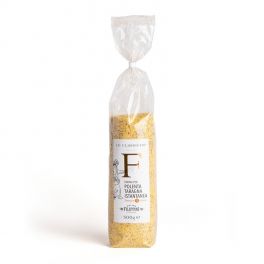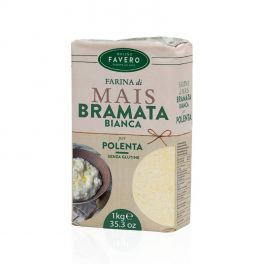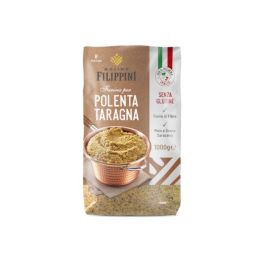Polenta flour for sale online
Polenta flour online offers
The Characteristics of Polenta Flour
Origin and History of Polenta Flour
Polenta flour has an ancient and fascinating history, which has its roots in the culinary traditions of the Italian regions. Dating back to ancient times, when corn was a staple crop for the indigenous populations of the Americas, polenta has won the hearts of Italians over the centuries.
Ancient Origins
The cultivation of corn and the production of polenta flour are practices that spread to Europe after contact with the New World. However, polenta was initially a food of the peasant class, as corn was cheaper and easier to grow than other cereals.
Regional History
Each Italian region has its own variation of polenta, with unique recipes and culinary traditions. For example, polenta taragna from Valtellina is prepared with corn flour and buckwheat flour, while polenta concia from Valle d'Aosta is enriched with local cheese.
Composition and Nutritional Properties
Polenta flour is obtained by finely grinding corn, which makes it rich in complex carbohydrates, fiber, vitamins and minerals essential for a balanced diet.
Carbohydrates and Fibre
Being primarily composed of complex carbohydrates, polenta flour provides slow-release energy, keeping blood sugar levels stable. The fibers present in corn flour also promote digestive health and a sense of satiety.
Vitamins and Minerals
Polenta flour is a good source of vitamin A, B vitamins and minerals such as iron, magnesium and phosphorus. These nutrients are crucial for supporting the body's vital functions and promoting overall health.
Grinding and grain size
The grain size of polenta flour can vary from fine to medium to coarse, affecting the consistency of the finished polenta. The finer flour tends to produce a smoother and more delicate polenta, while the coarser flour gives a more rustic and full-bodied consistency.
Type of Corn Used
Polenta flour can be made from different varieties of corn, each with unique flavor and color characteristics. Some varieties may be sweeter and more aromatic, while others may have a more robust and earthy flavor.
Production Methods
Polenta flour production methods can affect its flavor, texture and nutritional properties. Stone grinding, for example, keeps the properties of corn intact, producing a flour richer in nutrients and with a more pronounced flavour.
In the vast panorama of polenta flours available on the market, it is essential to understand the differences between the various varieties to make the choice best suited to your culinary and taste needs.
Type of Corn Used
The varieties of corn used in the production of polenta flour can significantly influence its flavor, texture and nutritional properties.
White Corn: White corn is one of the most common types used in the production of polenta flour. It has a sweet and delicate flavour, and is particularly suitable for classic creamy polenta preparations.
Yellow Corn: Yellow corn is another popular variety, featuring a stronger flavor and more vibrant color. Yellow corn flour produces a more full-bodied and aromatic polenta, ideal for accompanying tasty dishes such as braised meats and stews.
Flour grain size
The grain size of polenta flour is another element to consider when choosing the product best suited to your culinary preferences.
Fine: Fine polenta flour produces a smooth, velvety polenta, perfect for refined dishes and elegant presentations.
Medium: Medium polenta flour has a slightly coarser grain size, giving the polenta a more rustic texture and more robust character.
Coarse: Coarse polenta flour produces a polenta with a grainier and more rustic consistency, ideal for traditional dishes and rustic preparations.
Production Methods
Polenta flour production methods can vary from brand to brand and affect the final result of the product.
Stone Grinding: Stone grinding is a traditional method that keeps the properties of corn intact, producing a flour richer in nutrients and with a more pronounced flavour.
Roller Milling: Roller milling is a faster and more efficient industrial process, producing a more uniform polenta flour but with a slightly less pronounced aroma and flavor.
Health and wellness
Polenta flour is not only a versatile ingredient in the kitchen, but it also offers a number of health and wellness benefits, making it an ideal choice for a balanced diet.
Reduced Amount of Fat and Cholesterol
Polenta flour is naturally free of saturated fat and cholesterol, making it a healthy choice for those trying to keep fat intake in check in their diet. Furthermore, it is also a suitable alternative for those following a low-fat diet.
Rich in Complex Carbohydrates
Being primarily composed of complex carbohydrates, polenta flour provides slow-release energy, keeping blood sugar levels stable over time. This is especially beneficial for those looking to manage their energy throughout the day.
Source of Dietary Fiber
Polenta flour is also a good source of dietary fiber, which is important for digestive health and regular bowel function. The fibers present in corn flour promote intestinal transit and can help reduce the risk of digestive diseases.
Rich in Vitamins and Minerals
Polenta flour is enriched with B vitamins, which play an essential role in energy metabolism and nervous system health. Furthermore, it is a source of minerals such as iron, magnesium and zinc, which are important for various physiological processes in the human body.
Incorporating polenta flour into your diet can help improve your overall health and well-being, giving you a tasty and nutritious option for a variety of dishes. When looking for polenta flour online, keep these benefits in mind to make the best choice for you and your family.
Versatility in the Kitchen
Polenta flour is an incredibly versatile ingredient that can be used to make a wide range of delicious and creative dishes in the kitchen. Its unique texture and robust flavor make it suitable for multiple uses, satisfying the most demanding palates.
Creamy Polenta
One of the most classic preparations with polenta flour is creamy polenta, a comforting and nutritious dish that can be served alone or as a side dish. The creamy polenta is an excellent base for tasty sauces, sautéed mushrooms, melting cheeses or meat sauce.
Grilled Polenta
Grilled polenta is a versatile and tasty dish that lends itself perfectly to being served as an appetizer, side dish or main course. After the polenta has cooled and solidified, you can cut it into slices and grill it until you get a golden, crunchy crust on the outside and a soft center on the inside.
Fried polenta
Fried polenta is a crunchy and delicious alternative to traditional French fries. After the polenta has cooled and solidified, you can cut it into sticks or slices and fry it in boiling oil until golden brown. Fried polenta can be served as a snack, accompanied by sauces or condiments of your choice.
Baked Polenta
Baked polenta is a hearty, comforting dish that combines the creaminess of polenta with the addition of cheese and other tasty ingredients. After cooking the polenta, you can transfer it to a baking tray, add cheese, vegetables or meat to taste and gratinate it in the oven until you obtain a golden and crunchy surface.
The versatility of polenta flour makes it an essential ingredient in the kitchen, capable of enriching any recipe with its characteristic flavor and consistency. When looking for polenta flour online, consider the many possibilities of use and let yourself be inspired by culinary creativity
Factors to Consider in Selection
Type of Grinding: Polenta flour is available in different consistencies, from fine to coarse. The choice depends on the type of dish you want to prepare and your personal preference.
Origin and Quality of Corn: Make sure you choose a high-quality polenta flour, preferably produced with corn of controlled origin and grown sustainably.
Quality Certifications: Look for brands that offer certified polenta flours, such as organic ones or those with nationally or internationally recognized quality marks.
Production Methods: Check the manufacturer's production practices, ensuring they meet high standards of hygiene and food safety.
Availability and Price: Consider the availability of polenta flour online and in physical stores in your area, as well as the value for money offered by the product.
Tips for Storing and Making the Best Use of Polenta Flour
When it comes to storing and making the best use of polenta flour, there are some helpful tips to keep in mind to ensure the freshness and quality of the product.
Correct Storage:
Store polenta flour in a cool, dry and dark place to avoid exposure to humidity and direct light, which could compromise its freshness.
Transfer the flour to an airtight container or sealable bag to protect it from moisture and any external contamination.
Optimal Cooking Techniques:
Use quality water or broth to cook the polenta, gradually adding the flour to avoid lumps forming.
Stir the polenta constantly during cooking to ensure that it does not stick to the bottom of the pan and that it reaches a creamy, lump-free consistency.
Frequently Asked Questions about Using Flour for Polenta
When it comes to using polenta flour, some common questions may arise that are important to address to have a clear understanding of the product and its optimal use. Here are some of the most frequently asked questions:
What are the differences between corn flour and polenta flour?
Cornmeal is a finely ground flour obtained by grinding yellow or white corn, while polenta flour is a variety of cornmeal specifically designed for making polenta.
Polenta flour is generally coarser than traditional corn flour and can have a grainier texture to create a more rustic, traditional polenta.
Can I Use Polenta Flour for Desserts?
Yes, polenta flour can be used in the preparation of desserts, adding a rustic touch and a distinctive flavor to sweet recipes.
You can use polenta flour in making biscuits, cakes, muffins and even sweet polenta for unique and delicious desserts.
Is Polenta Flour Also Suitable for People with Food Intolerances?
Polenta flour is naturally gluten-free, making it suitable for people with gluten intolerance or celiac disease.
It is important, however, to always check the product label to confirm that the polenta flour has been produced in a contamination-free environment and has not been contaminated with gluten during the manufacturing process.

-

Flour for instant polenta taragna 500g Molino Filippini
Ready to ship in 1 days, delivery time 1-3 days


 Italiano (IT)
Italiano (IT)  Deutsch (DE)
Deutsch (DE)  Français (FR)
Français (FR)  Español (ES)
Español (ES)  Polish (PL)
Polish (PL) 

This website is protected by reCAPTCHA and the Privacy Policy & Terms and Conditions of Google